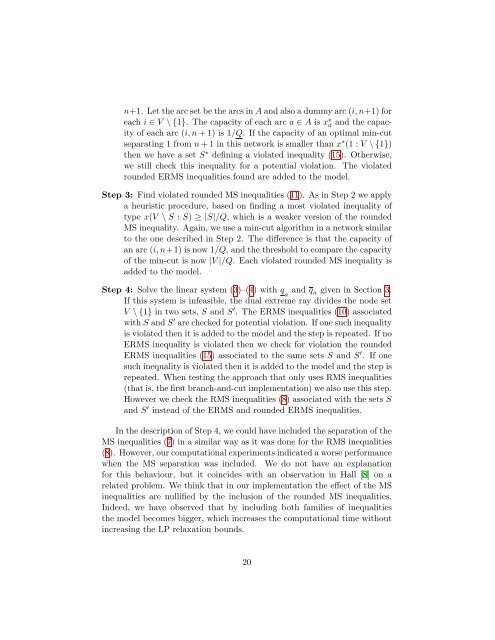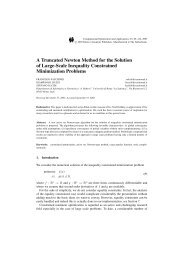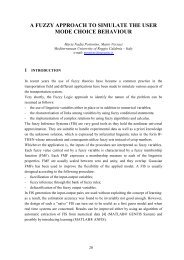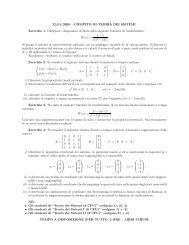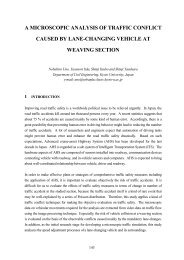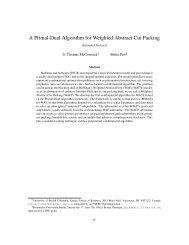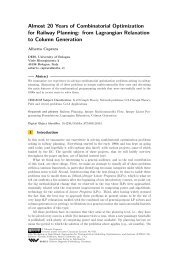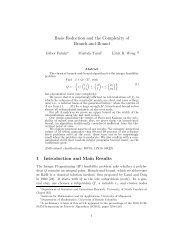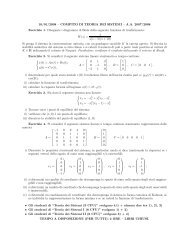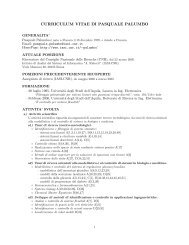Reverse Multistar Inequalities and Vehicle Routing ... - IASI-CNR
Reverse Multistar Inequalities and Vehicle Routing ... - IASI-CNR
Reverse Multistar Inequalities and Vehicle Routing ... - IASI-CNR
You also want an ePaper? Increase the reach of your titles
YUMPU automatically turns print PDFs into web optimized ePapers that Google loves.
n+1. Let the arc set be the arcs in A <strong>and</strong> also a dummy arc (i, n+1) for<br />
each i ∈ V \ {1}. The capacity of each arc a ∈ A is x ∗ a <strong>and</strong> the capacity<br />
of each arc (i, n + 1) is 1/Q. If the capacity of an optimal min-cut<br />
separating 1 from n + 1 in this network is smaller than x ∗ (1 : V \ {1})<br />
then we have a set S ∗ defining a violated inequality (15). Otherwise,<br />
we still check this inequality for a potential violation. The violated<br />
rounded ERMS inequalities found are added to the model.<br />
Step 3: Find violated rounded MS inequalities (11). As in Step 2 we apply<br />
a heuristic procedure, based on finding a most violated inequality of<br />
type x(V \ S : S) ≥ |S|/Q, which is a weaker version of the rounded<br />
MS inequality. Again, we use a min-cut algorithm in a network similar<br />
to the one described in Step 2. The difference is that the capacity of<br />
an arc (i, n+1) is now 1/Q, <strong>and</strong> the threshold to compare the capacity<br />
of the min-cut is now |V |/Q. Each violated rounded MS inequality is<br />
added to the model.<br />
Step 4: Solve the linear system (3)–(4) with q a <strong>and</strong> q a given in Section 3.<br />
If this system is infeasible, the dual extreme ray divides the node set<br />
V \ {1} in two sets, S <strong>and</strong> S ′ . The ERMS inequalities (10) associated<br />
with S <strong>and</strong> S ′ are checked for potential violation. If one such inequality<br />
is violated then it is added to the model <strong>and</strong> the step is repeated. If no<br />
ERMS inequality is violated then we check for violation the rounded<br />
ERMS inequalities (15) associated to the same sets S <strong>and</strong> S ′ . If one<br />
such inequality is violated then it is added to the model <strong>and</strong> the step is<br />
repeated. When testing the approach that only uses RMS inequalities<br />
(that is, the first branch-<strong>and</strong>-cut implementation) we also use this step.<br />
However we check the RMS inequalities (8) associated with the sets S<br />
<strong>and</strong> S ′ instead of the ERMS <strong>and</strong> rounded ERMS inequalities.<br />
In the description of Step 4, we could have included the separation of the<br />
MS inequalities (7) in a similar way as it was done for the RMS inequalities<br />
(8). However, our computational experiments indicated a worse performance<br />
when the MS separation was included. We do not have an explanation<br />
for this behaviour, but it coincides with an observation in Hall [8] on a<br />
related problem. We think that in our implementation the effect of the MS<br />
inequalities are nullified by the inclusion of the rounded MS inequalities.<br />
Indeed, we have observed that by including both families of inequalities<br />
the model becomes bigger, which increases the computational time without<br />
increasing the LP relaxation bounds.<br />
20


